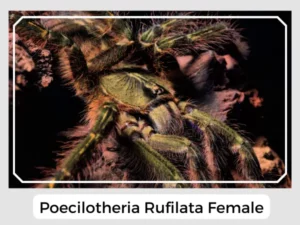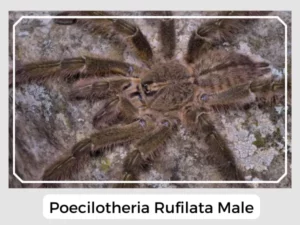The slate-red ornamental tree spider, part of the tarantula family, calls the Western Ghats in India its home. Get ready to discover intriguing facts about this fascinating spider as you read on!

Photo Credit: Michael Pankratz

Photo Credit: Michael Pankratz
The orange-to-brown eggs are laid inside a sac made of webbing.
They are very fast, becoming quite strong as they mature.
Similar to other tarantulas, they are ambush predators who do not generate a lot of webbing.
Yes, Slate-red Ornamental Tree Tarantulas are venomous, like most tarantulas. Their venom helps them subdue prey.
Compared to other tarantulas, these spiders are flighty, skittish, and quick to bite if agitated. Their venom is quite potent, with some bites even leading to hospitalization, though there are no recorded deaths.
The slate-red ornamental tree spider plays a crucial role in its habitat as a predator, keeping the insect population in check and thereby supporting the health of the local ecosystem.
Natural Predators: In the wild, they are prey to birds, larger mammals, and even other spiders, which helps to maintain the natural balance of species within the Ghats.
Prey-Predator Dynamics: Their predation not only controls the populations of their prey but also influences the spatial distribution and behavior of smaller creatures in their ecosystem.
Relationship with Humans: Humans impact these spiders significantly through habitat disruption and illegal pet trade, yet the spiders themselves pose little threat to humans when left undisturbed in their natural environment.
| Other names | Red slate ornamental tarantula, reddish parachute spider, Travancore slate-red tarantula, or Rufus parachute spider |
| Lifespan | Males: 2-3 years Females: 11-12 years |
| Distribution | The south Western Ghats of India |
| Habitat | Rock crevices as well as in tree bark and hollows |
| Diet | Cockroaches, crickets, and locusts. Some have been noted to trap and eat bats. |
In conclusion, the slate-red ornamental tree spider is not only a species of great beauty but also of ecological importance.
The slate-red ornamental tree spider, part of the tarantula family, calls the Western Ghats in India its home. Get ready to discover intriguing facts about this fascinating spider as you read on!

Photo Credit: Michael Pankratz

Photo Credit: Michael Pankratz
The orange-to-brown eggs are laid inside a sac made of webbing.
They are very fast, becoming quite strong as they mature.
Similar to other tarantulas, they are ambush predators who do not generate a lot of webbing.
Yes, Slate-red Ornamental Tree Tarantulas are venomous, like most tarantulas. Their venom helps them subdue prey.
Compared to other tarantulas, these spiders are flighty, skittish, and quick to bite if agitated. Their venom is quite potent, with some bites even leading to hospitalization, though there are no recorded deaths.
The slate-red ornamental tree spider plays a crucial role in its habitat as a predator, keeping the insect population in check and thereby supporting the health of the local ecosystem.
Natural Predators: In the wild, they are prey to birds, larger mammals, and even other spiders, which helps to maintain the natural balance of species within the Ghats.
Prey-Predator Dynamics: Their predation not only controls the populations of their prey but also influences the spatial distribution and behavior of smaller creatures in their ecosystem.
Relationship with Humans: Humans impact these spiders significantly through habitat disruption and illegal pet trade, yet the spiders themselves pose little threat to humans when left undisturbed in their natural environment.
| Other names | Red slate ornamental tarantula, reddish parachute spider, Travancore slate-red tarantula, or Rufus parachute spider |
| Lifespan | Males: 2-3 years Females: 11-12 years |
| Distribution | The south Western Ghats of India |
| Habitat | Rock crevices as well as in tree bark and hollows |
| Diet | Cockroaches, crickets, and locusts. Some have been noted to trap and eat bats. |
In conclusion, the slate-red ornamental tree spider is not only a species of great beauty but also of ecological importance.